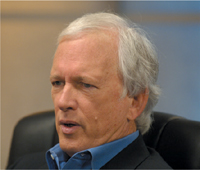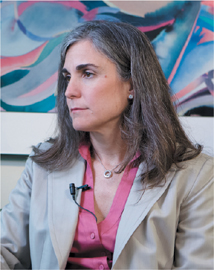CHAPTER
8
Topic Change:
Time to Improvise
I don’t know why we’re spending time on this when the fundamental problem is the product structure.
—Dan Warmenhoven
Presentations at the top level can change directions midstream. That’s not surprising considering who’s involved, what’s at stake, and the fact that they’re often more like guided discussions than structured lectures. What should you do when the executives want to address a different topic? You’ll find your answer in jazz. Yes, jazz. Like a jazz musician, your ability to improvise in the heat of the moment may be the difference between success and failure.

Eddie Harris
Jazz saxophone player, Eddie Harris (1934–1996), told me in a 1976 interview, “Jazz is a business. I have to read the audience. If I’m playing far out, and I see they want a ballad, I’ll change in the middle of the tune.” Business presenters should take their cue from Eddie Harris. Should topics switch in the middle of your presentation, be prepared to go with the flow.
When we think of improvisation, we think of jazz and comedy clubs. Improv comedy involves themes provided on the spur of the moment from the audience. Similarly, jazz improvisation occurs in the moment as the players “riff” off of each other. We don’t think of high-level business meetings being improvisational, or off the cuff. But, in fact, the most creative business solutions often evolve from improvisational interactions. Jazz metaphors are not uncommon in business:
From a CEO: Mike Lyons uses a jazz metaphor to explain business interactions, “As a CEO, I have to let everyone play. You can’t run them over. See what melody they come up with and play with that. Otherwise, why are they there? Don’t shut them down. It becomes a bad place to work.”

Mike Lyons
From a Jazz Drummer: Akira Tana recalled, “Miles Davis was a great CEO of a jazz company. He allowed people to express themselves and to contribute, and it nurtured them. Many went on to become leaders of their own groups.”

Akira Tana
From a Corporate VP: Mark Shaw, former VP of HR with Applied Materials, facilitated high-level decision meetings. “In board meetings I think of the CEO’s staff as band members,” he told me. “So, what is the dynamic of the CFO and CEO? They are key players. What are they saying to me? I’m trying to incorporate their pieces into the ‘music’ that is being played in the room. For example, we were having a financial crisis. I was trying to hear what the CFO was saying and link it to what the CEO was saying. I was trying to get all the players on the same page about what had to happen. We were all in the same band.”

Mark Shaw
From a State University: The business school at San Francisco State University brings jazz improvisation into the business community to help business leaders loosen up the decision processes. The program is called, “Jazz at Work.” Here is how they describe the improvisational parallels between jazz and business:
Jazz is an exciting metaphor for high performance organizations. It’s a collective and improvisational art form based on high levels of team creativity. Businesses today are without a score to play by, and managers need to learn to think like the best jazz musicians. Lessons from jazz can teach businesses how to improvise, manage change, and drive innovation in real time.
If improvisation is so powerful, why don’t we hear more about it in business? The answer: fear. Like the presenter who cannot let go of the PowerPoint slides, many in business fear that a free-form meeting will spiral out of control. However, all indications are that in most corporate environments it is far riskier to do nothing. Robert Lutz, former Vice Chairman of General Motors, and a noted creative force in the car industry advised, “The biggest risk is no risk at all.”
For Randi Feigin, Vice President, Juniper Networks, the biggest risk proved to be her inability to follow the lead that the executives set.

Randi Feigin
Topic Change
“I felt so alone and out there, so vulnerable. It was horrible.”
In her 12 years with Juniper, Randi has held two other VP positions: Business Process Reengineering and Investor Relations. Randi’s goal in the meeting was to get executive buy-in, endorsement, and support for a new company-wide program. She worried about the executives’ demands to “keep it at a high level,” and at the same time to go deep and clarify all the details.
Unfortunately for Randi, her topic wound up triggering other executive concerns. As she was enumerating why people would potentially resist the change she was proposing, they stopped listening and spun off in other directions. Instead of leading the presentation, Randi found herself sidelined and barely able to get a word in edgewise.
“Can we maybe go back to the slides?” she finally asked tentatively during a lull in the discussion swirling around her. Her request was shot down just as completely as her efforts to get their approval for the program she was pitching.
Reflecting on her initial failure, Randi said, “No matter what I did, I couldn’t get them back on track to focus on my proposal.” Because she didn’t get the support she needed, she felt the program was going to fail. By the end, she was totally demoralized.
The problem she was trying to solve wasn’t the problem that the executives were interested in solving. But Randi simply couldn’t switch directions. To make things worse, her sponsor let her flounder instead of jumping in.
Executive Advice:
All ‘big dogs’ aren’t equal. You have to pick up on where the biggest dog is headed. You have to be willing to abandon your presentation, pick up on that conversation, and try to lead it to where you want to go.
—Robert Drolet
If the presenter is a more junior person, the only person who can get it back on track is the sponsor.
—Dan Eilers
Let people have the back-and-forth dialogue, but then be attentive to when it is the right time to jump back in to get people back on topic. The best way to do that is to look to your sponsor for help.
—Corinne Nevinny
When the executives veered from the topic Randi wanted to discuss, it was because they felt something more pressing had to be resolved before they could consider her proposal. The challenge for Randi was to recognize the issues the executives thought were important and to address them head on. She and her sponsor needed to find the right moment to jump into the discussion, deal with the questions, and then clarify the next step, i.e., redirect the discussion, postpone it, or make a follow-up plan.
Sponsor’s Help
After getting executive advice, Randi’s second presentation was a success. When the executives went off topic and brought up detailed product issues, she took a more assertive approach and stepped in with a direct response. When that failed, she appealed to her sponsor for help. He was able to redirect the conversation and she got what she wanted.

Randi commented, “I wanted to step in, but was concerned about being too aggressive. So I looked to my executive sponsor for support because he’s allowed to be more aggressive.” That helped refocus the group and win the day.
Summary
To avoid the traps of Topic Change:
• Acknowledge the topic change
• Handle objections
• Get help from your sponsor
• Agree to follow up
